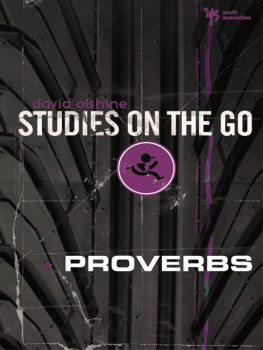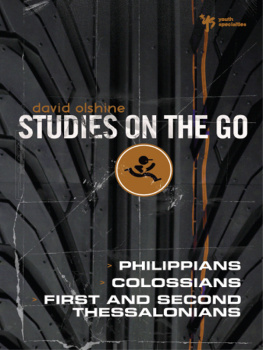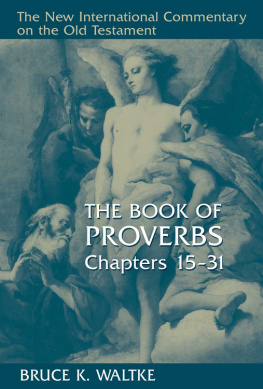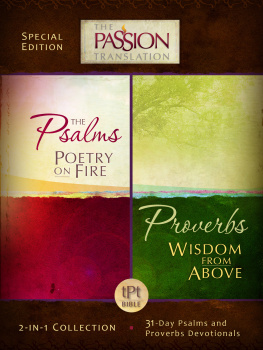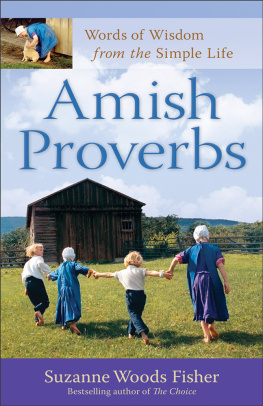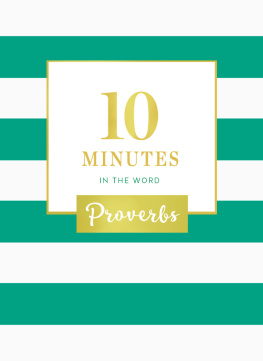
YOUTH SPECIALTIES
STUDIES ON THE GO: PROVERBS
Copyright 2009 by David Olshine
All rights reserved under International and Pan-American Copyright Conventions. By payment of the required fees, you have been granted the non-exclusive, non-transferable right to access and read the text of this e-book on-screen. No part of this text may be reproduced, transmitted, down-loaded, decompiled, reverse engineered, or stored in or introduced into any information storage and retrieval system, in any form or by any means, whether electronic or mechanical, now known or hereinafter invented, without the express written permission of Zondervan.
ePub Edition August 2009 ISBN: 978-0-310-86745-6
Youth Specialties resources, 300 S. Pierce St., El Cajon, CA 92020 are published by Zondervan, 5300 Patterson Ave. SE, Grand Rapids, MI 49530.
Library of Congress Cataloging-in-Publication Data
Olshine, David, 1954
Proverbs / by David Olshine.
p. cm. (Studies on the go)
ISBN 978-0-310-28548-9
1. Bible. O.T. ProverbsStudy and teaching. I. Title.
BS1467.O47 2009
223'.707dc22
2009009968
All Scripture quotations, unless otherwise indicated, are taken from the Holy Bible,TodaysNew International Version. TNIV. Copyright 2001, 2005 by International Bible Society. Used by permission of Zondervan. All rights reserved.
Any Internet addresses (websites, blogs, etc.) and telephone numbers printed in this book are offered as a resource. They are not intended in any way to be or imply an endorsement by Youth Specialties, nor does Youth Specialties vouch for the content of these sites and numbers for the life of this book.
All rights reserved. No part of this publication may be reproduced, stored in a retrieval system, or transmitted in any form or by any means electronic, mechanical, photocopy, recording, or any other except for brief quotations in printed reviews, without the prior permission of the publisher.
Cover design by Toolbox Studios
09 10 11 12 13 14 20 19 18 17 16 15 14 13 12 11 10 9 8 7 6 5 4 3 2 1
DEDICATION
To the love of my life, my wife and soul mate Rhonda. What would life be like without you? Every day with you is a gift. Boy, did I marry over my head!
To my children, Rachel and Andrew. May you continue to grow in the wisdom of God. I love you!
To my mom, who taught me to live life in the moment.
To Keith Wasserman, one of the wisest persons I know. Thanks for our lifelong friendship.
ACKNOWLEDGMENTS
To Tom Walsh and the Maxwells kindness for allowing me to use their condo in Florida to write this project.
To my soul brothers Larry Wagner and Hule Goddard. Thanks for the weekly times of prayer, laughter, sharing, and cinnamon crunch bagels.
SPECIAL THANKS TO MY RESEARCH TEAM
To my writing and research team, graduates of Columbia International University in Columbia, SC. Nick Cunningham, Trevor Miller, Anne Lord Bailey, and Rachel Olshine; and Kaisi Thanks for your diligent work and great insight.
CONTENTS
INTRODUCTION
How to Use Studies on the Go
Studies on the Go have all of the best ingredients for helping students and adults connect with God and each other as they encounter Scripture. These studies work best in a small group, but can also be utilized in Bible studies, Sunday school, or youth group or even on road trips and retreats.
Each session is broken up into the following subsections:
1. Leaders Insight: A brief overview for each lesson to help the leader/facilitator understand the historical background, focus, and purpose of the text.
2. Share (warm-up questions): Before jumping in and studying the Bible, it helps to allow time for your group to connect relationally first. Warm-up questions are lighter and help your group get comfortable interacting with one another.
3. Observe (observation questions): These questions help your groupregardless of their Bible knowledgefocus onWhat does the passage say? andWhat is the author communicating? The goal is to bring to the surface what the students are noticing about the passage.
4. Think (interpretation questions): These are a set of questions helping your group consider what the author meant when he wrote the letters. The goal is to discover what the writer was saying to his audience.
5. Apply (application questions): These questions are focused on helping the group connect Gods truth to their own lives.
6. Do: An additional activity option that helps students experientiallyflesh out the lesson. The goal here is action, putting head knowledge into real-life practice.
7. Quiet Time Reflections: One reproducible handout page for each session providing additional exercises to help students personally reflect on the passages on a daily basis.
My hope is that these studies create an environment where students and adults experience community. The leaders job is to facilitate a safe place in which people can be known and share freely. The best small groups are fluid, organized, free-flowingwith each person sharing.
May God bless you as you engage students in the process of applying Gods truth to their lives.
Blessings,
Dr. David Olshine
WHO? Most scholars believe King Solomon compiled these sayings known as Proverbs. Solomon loved knowledge as a young person (1 Kings 3:9-12). Bill T. Arnold and Bryan E.Beyers Encountering the OldTestament refers to Solomons status as a world leader, a brilliant and discerning man (Grand Rapids, MI: Baker Academic, 1999). He had vast interests in politics, science, business, and spiritual issues (see also 1 Kings 4:29-31).
WHAT? Proverbs are short, pithy sayings that provoke a nonresponsere practical in nature and teach lessons about life. The Book of Proverbs is a call to experience wisdom. Wisdom is personified in the form of a woman calling out to us, mocking the person who doesnt listen to her, because to resist wisdom leads often to poor choices. The Jewish perspective is that all of wisdom is wrapped up inwho God is and that this God can be known and personally experienced.
Wisdom from the Proverbs calls us to a vertical dimension, relating to God through prayer and solitude. The Proverbs also call us toward wisdom in the horizontal issues of life: Child rearing, fearing God, helping the oppressed, responding to the poor, and counseling others. When we choose to live selfishly, Proverbs calls this foolishness; when we choose to live Gods way, we experience wisdom.
WHY? The Proverbs were written in a simple way so readers would experience wisdom, discernment, justice, learning, and guidance.Wisdom is mentioned over 40 times in the book of Proverbs. Chapter 1 is a call to listen and apply wisdom.
WHERE? Proverbs follows the book of Psalms written by King David. The Psalter (another name for Psalms) is a collection of poems and wrenching cries from the heart. King David sets the stage for Solomons writings by saying in Psalm 49:4,I will turn my ear to a proverb. Ecclesiastes is the book following Proverbs, also written by King Solomon. Ecclesiastes is only 12 chapters, and Solomons thesis is simple: Life without God at the core of our being is meaningless and empty. The finale of Solomons trilogy follows Ecclesiastes in the Song of Songs. These are love songs and poetry between a man and a woman that mirror Gods love for his people. These three books are rooted in Solomons desire to communicate to us how to live life to the fullest.
1. BABY STEPS
Proverbs 1

Next page
